Thanks to Apple and other manufacturers of phones and portable audio players, earbuds have been the most common type of stock headphone for more than a decade and remain extremely popular to this day. Though great strides have been made in sound quality and ergonomics, the most obvious example being the Apple AirPods, there is still room for improvement in both sound and fit for many users. Earphones, often referred to as In-Ear Monitors, or IEMs, offer the potential for great comfort and sound quality for a variety of ears, but rely heavily on a good seal with the ear canal. There are also many Bluetooth True Wireless or TWS, earphones that ditch the cable but still require a good seal between the earphone and ear canal.
One of the most important aspects of obtaining a good fit is to protect your hearing long-term. A recent study reported individuals who use earphones in an already noisy environments are a 4.5-fold higher risk of hearing loss, so keeping isolation as high as possible to enable lower volume levels is critical! This earphone fit guide is designed to help you achieve the best seal, comfort, sound quality, and secure fit from your IEMs.
INDEX
Notes for the Beginner – a good place to start
Earbuds, Earphones, & IEMs – more detailed information about earbud types and fit
The Importance of fit
Ear Tips – detailed information on ear tips
Wear Style
Nozzle Size – coming soon
If you are new to in-ear earphones/IEMs, your first experience can be a negative one. Many people simply don’t like to stick anything in their ears, but earphones require an airtight seal between ear tip and ear canal. If you take a look at image A in figure 1 you will see that they sit in the outer part of the ear while image B shows the ear tip inside the ear canal.
The quick steps for the beginner to get the best, most secure, and comfortable fit to go with full sound are as follows:
1) Is your earphone designed to have the cable go down, go over-the-ear, or both (see Wear Style)? I have seen people wear over-the-ear earphones with the cable down resulting in a horrible experience. The packaging and/or product page should show the proper wear style. Also, make sure to follow the left/right markings.
2) Use the proper-sized ear tips. Earphones usually come with multiple sizes of ear tips. Trying all the sizes that come with the earphone will help you achieve the best combination of comfort, security, and good sound quality. Even if you have preconceived thoughts about the size of your ear/ear canal, a particular ear tip may fit better than others. For example, if you have medium-sized ear canals, a small ear tip will allow the earphone to fit deeper, which may give a better result. Or, a larger ear tip may sit further out for better comfort, and with the size of your ear or an over-the-ear wear style, still stay put.
3) Adjust the angle the nozzle enters your ear canal. Ear canals are angles forward and up, so the nozzle should also be aimed in that direction. Once inserted, or while inserting an earphone, try different angles with different ear tips to see what feels the best and provides the best seal and comfort.
4) Adjust the depth of insertion. Typically, the deeper the insertion, the better the seal and isolation, but sound quality varies as some earphones sound better with a shallow insertion while others sound better with a deep insertion. Experiment with different insertion depths until you find what works best for you with the particular earphone.
5) Reduce cable noise. Cable noise caused by the cable rubbing against clothing or other objects is called microphonics. If your earphone has microphonics, there are some ways to reduce or eliminate it.
a) If your earphone uses a cable-down configuration, try to wear the cable over-the-ear.
b) Tighten a cable cinch, which is a slider that holds the two parts of the cable together past the Y-split, which is where the cable separates for each channel.
c) Wear the cable under your clothing.
d) Wear the cable behind your back. This may work for when you are up and about, but typically not when you are doing something like sitting at a desk.
6) Listen at the lowest possible volume. Many people love to crank-up the volume so loud you can hear their earphone 10 feet away. This will most certainly lead to Noise Induced Hearing Loss (NIHL) over time, and the unfortunate part of the equation is the affected people won’t know for years until it is way too late. Doing the above to get the best seal and noise isolation for earphones/IEMs will allow you to listen at a lower volume and protect your hearing. This becomes more important as your environment becomes louder. I personally try to keep the volume as low as possible and give it 5 minutes or so to let my ears adjust and I am usually fine.
While you may find a great configuration for one earphone, another could require a completely different setup due to a different shape, design, ear tip style, etc. It is best to go through this process for different earphones to achieve the highest levels of performance.
EARBUDS, EARPHONES, & IEMs
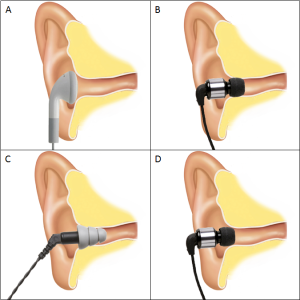
A) Conventional Earbuds: Earbuds sit in the outer ear and create a loose seal at best, as shown in Figure 1 A. Typically, they provide low isolation from outside noise and need to be turned up louder in noisy environments. In addition to low isolation, the lack of a seal typically results in a lower quantity of bass, especially deep bass, compared to other types of headphones. The one-size-fits-all nature of earbuds will result in many users having trouble achieving the best comfort, sound quality, and/or secure fit with earbuds.
B) In-Ear Monitors: In-ear monitors (IEMs), characterized by having ear tips that form a seal with the ear canal, as shown in Figure 1 B, are also commonly called in-ear headphones or earphones. IEM performance is heavily dependent upon ear tips, which we’ve seen called ear nubs, ear bits, inserts, fittings, etc., to determine sound quality, comfort, isolation, and fit security.
C) Types of IEMs: While “IEM” was a term originally specific for earphones designed to insert deep into the ear as shown in Figure 1 C, it has evolved to broadly correspond to pretty much all in-ear headphones. A sub-category, “canalphones”, implies earphones that require a shallower seal (Figure B). Canalphones typically block out less external noise than IEMs, but with the number of different offerings on the market, the lines between canalphones and IEMs have become very blurred. We typically refer to all in-ear headphones as “earphones” or “IEMs.”
D) Driver Type: IEMs typically use one of two driver (speaker) types: dynamic drivers and balanced armature drivers. Dynamic driver IEMs are typically much more tolerant of fit issues as the larger driver moves more air and works better in a semi-sealed environment. Balanced armature drivers on the other hand are precision devices that need a good seal to recreate bass to their full potential, which is typically at a lower level than dynamic drivers to start. No seal = no bass, and a partial seal, such as that shown in Figure 1 D, equal light bass with a dynamic driver IEM but no bass with most balanced armatures.
Regardless of the true name of an IEM (see Types of IEMs above), fit and the seal are key for performance. Assuming the earphone is being worn the correct way, meaning over-the-ear when required, you may have an improper seal if:
- The sound is tinny, treble-heavy sound, or lacks bass response
- You experience improper stereo imaging with a characteristically “distant” sound
- Your IEMs don’t stay in your ears during no or light activity
- Your IEMs don’t isolate outside noise
There is a good number of people who don’t know how to get the best fit and seal, as can be seen in some over-the-ear and balanced armature models of earphones on Amazon. When someone bucks the trend and says there is no bass from a known bass-heavy IEM, it most likely isn’t the product, but the user (although products can be defective).
If you are experiencing any of the above issues, try pushing the IEMs deeper into your ear canal and/or try different ear tips. Using an incorrectly sized eartip can have other negative effects on the seal, such as an eartip that is too small may not reach the sides of the ear canal for an airtight fit while one that is too large can make getting a deep enough seal impossible or – in some cases – can even collapse inside the ear canal, again preventing a good seal and reducing comfort.
Other factors that can affect fit include insertion angle, earphone design, and earphone wear style. The ear canal is naturally angled slightly towards the front and top of the head, and angling the earphone appropriately during insertion can help. In addition, wearing IEMs “over-the-ear” by wrapping the cable around your ear before inserting the earphones, can often help avoid parts of the ear anatomy that can otherwise prevent a good seal. I can usually get a much deeper and therefore better seal by wearing IEMs that are designed for cable-down use with the cable over the ear.
Most earphones will have a very noticeable reduction in outside noise when a proper seal is achieved. There are some exceptions, such as the relatively rare open-backed IEM, or some that are just poorly designed and don’t offer a lot of isolation, which would be indicated in the isolation rating for the review. It is also important to note that most IEMs won’t completely block out external noise, and your awareness level, anatomy, ear tips, IEM design, and music volume will all contribute to how much external noise you can hear.
Ear tips are the interface between the earphone and your ear canal. Everybody’s ears are unique, so certain ear tips may work better for you than others. Typically, a minimum of three sizes of ear tips are included with an earphone, but there can be multiple sizes and types, or in an extreme case, one size/style. NOTE: Please double-check that the linked products will fit your particular IEM or ear bud before purchase.
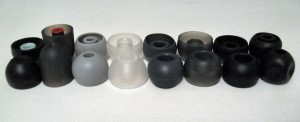
Single-flange: Single-flange ear tips are the most common ear tips, and as the name implies, they use a single piece of silicone to create a seal. There are significant differences in single-flange ear tips due to material density, thickness, and shape. The denser the material, the more isolation they will provide and the higher the level of bass. The thicker they are, the less pliable they will be, which may be good or bad. If they are too soft, they can collapse in the ear, which is affected also by shape, and if they are too hard, they can become uncomfortable. A very popular shape that works well with most ears is the Sony hybrid ear tips, which come in sizes based on their earphones but can stretch on larger nozzles. This pack includes four sizes and this one comes with three three. Westone sells Star silicone replacement ear tips in a fit kit or individual sizes that work well for many, and SpinFit makes well-engineered ear tips with many different nozzle sizes.
 Bi-flange: Bi-flange ear tips have a large and small flange on the same stalk and while there are many different sizes and shapes, there are far fewer options as they are less common. The advantage a bi-flange ear tip has over a single flange is it can have two independent areas that can seal with the ear canal, creating a better overall seal. This will result in more bass and isolation if you can get them to fit. The disadvantage is the limited sizes available, and if they don’t fit your ear, they will be useless. Lower profile bi-flange tips. Using a bi-flange ear tip when only the smaller flange creates a seal isn’t a good idea as it is best to use a single flange, which offers many more sizes and shapes.
Bi-flange: Bi-flange ear tips have a large and small flange on the same stalk and while there are many different sizes and shapes, there are far fewer options as they are less common. The advantage a bi-flange ear tip has over a single flange is it can have two independent areas that can seal with the ear canal, creating a better overall seal. This will result in more bass and isolation if you can get them to fit. The disadvantage is the limited sizes available, and if they don’t fit your ear, they will be useless. Lower profile bi-flange tips. Using a bi-flange ear tip when only the smaller flange creates a seal isn’t a good idea as it is best to use a single flange, which offers many more sizes and shapes.
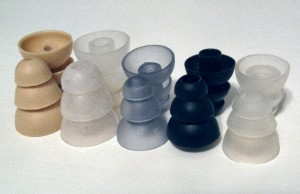 Triple flange: Triple flange ear tips take bi-flange ear tips to another level. When they fit, they provide a better seal and higher levels of isolation. They work well for getting the most out of many balanced armature earphones as the seal is critical for bass performance if your ear canals are deep enough. Triple flange ear tips typically work very well with earphones that have angled nozzles and those that use an over-the-ear fit. Most triple flange ear tips are soft, although the Westone style isn’t, and are susceptible to bending in the ear canal and muffling the sound. Triple flange ear tips are readily available, and this pack has multiple types of ear tips, including triple flange.
Triple flange: Triple flange ear tips take bi-flange ear tips to another level. When they fit, they provide a better seal and higher levels of isolation. They work well for getting the most out of many balanced armature earphones as the seal is critical for bass performance if your ear canals are deep enough. Triple flange ear tips typically work very well with earphones that have angled nozzles and those that use an over-the-ear fit. Most triple flange ear tips are soft, although the Westone style isn’t, and are susceptible to bending in the ear canal and muffling the sound. Triple flange ear tips are readily available, and this pack has multiple types of ear tips, including triple flange.
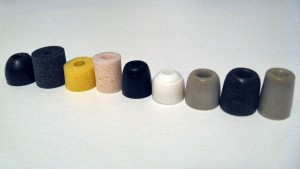 Foam: Foam ear tips are soft, compliant ear tips that conform to your inner ear. They come in a wide range of density and finish, and Comply has made foam ear tips extremely popular with their ultra-soft foam. Other foam is denser but will conform to your ear canal over time. Inserting foam ear tips is different than inserting a typical ear tip, as the foam should be compressed before the ear tip is inserted, and the earphone needs to be held in place until the foam expands back into shape. Foam offers an exceptional seal and high levels of isolation than silicone ear tips and often is more comfortable for long-term wear. The negative with foam, which is dependent upon the density, is that they don’t last as long as silicone ear tips, most can’t be cleaned, can be expensive, and some absorb some of the treble energy, changing the sound. There are many, many options these days including Comply (assorted sizes), Shure, Westone (thin earphone nozzles), JLab, and Sonicfoam.
Foam: Foam ear tips are soft, compliant ear tips that conform to your inner ear. They come in a wide range of density and finish, and Comply has made foam ear tips extremely popular with their ultra-soft foam. Other foam is denser but will conform to your ear canal over time. Inserting foam ear tips is different than inserting a typical ear tip, as the foam should be compressed before the ear tip is inserted, and the earphone needs to be held in place until the foam expands back into shape. Foam offers an exceptional seal and high levels of isolation than silicone ear tips and often is more comfortable for long-term wear. The negative with foam, which is dependent upon the density, is that they don’t last as long as silicone ear tips, most can’t be cleaned, can be expensive, and some absorb some of the treble energy, changing the sound. There are many, many options these days including Comply (assorted sizes), Shure, Westone (thin earphone nozzles), JLab, and Sonicfoam.
Hybrid: A cross between silicone and foam providing additional durability and the ability to clean the ear tips vs. a pure foam alternative and may work well if you can’t get the right fit with silicone and don’t want to spend on replacing foam often. There are a few options including AirFoams and Zotech. The AirFoams are also available for AirPod Pros. Hybrid ear tip isolation is typically on par with Foam.
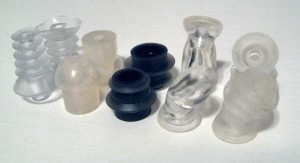 Other styles: There used to be a lot of non-standard ear tip options, but now it seems there are many fewer such as mushroom ear tips (I have tried the Sensorcom version, not these) and these, also called mushroom. If you have a large IEM collection and want to play around with different ear tips, there are a few other options available.
Other styles: There used to be a lot of non-standard ear tip options, but now it seems there are many fewer such as mushroom ear tips (I have tried the Sensorcom version, not these) and these, also called mushroom. If you have a large IEM collection and want to play around with different ear tips, there are a few other options available.
Custom-fit ear tips: Custom-fit ear tips are available for various earphones, and can possibly be made for any particular earphone upon request. They usually block the highest level of sound of the mentioned ear tip options. While I do think there is an improvement with custom-fit ear tips, the relatively high cost and low levels of improvement make recommending this style of ear tip a bit more challengeing. Use cases where custom ear tips make sense include:
- You are regularly in loud environments
- Use with very expensive IEMs you really like
- You have fit issues due to very small, very large, or non-standard shaped ear canals
- Your IEMs have bulky or odd-shaped housings that prevent a good seal
A custom-fit ear tip will genrerally only fit one nozzle size, ear bud, or earphone. A custom mold will be required, which will require a trip to an audiologist and an additional fee unless you are willing to take a self-impression, and you can get a self-impression kit here.
Most companies offer custom tips for specific earbud or earphone models including: Sensaphonics, Adv., Snugs (also make versions for use under a motorcycle helmet and for use while swimming/in water), Custom Art, and MicroSonic (I would recommend calling for more information). MEE Professional makes custom eartips for their products.
 Spacers: Earphone nozzles vary from manufacturer to manufacturer, so not all ear tips will fit all earphones. What happens if you have a smaller-sized nozzle but want to use ear tips with a larger diameter stalk? If you just put them on, they will end up stuck in your ears. Using a spacer will alleviate this issue, as it will fit securely on the earphone nozzle and allow the ear tip to fit snugly. The spacers I prefer are from Shure “Olive” foam tips, but you can use any foam insert or a small diameter plastic/rubber tube. If you do use a foam ear tip, use caution when removing the foam, and I recommend finding small tubing instead.
Spacers: Earphone nozzles vary from manufacturer to manufacturer, so not all ear tips will fit all earphones. What happens if you have a smaller-sized nozzle but want to use ear tips with a larger diameter stalk? If you just put them on, they will end up stuck in your ears. Using a spacer will alleviate this issue, as it will fit securely on the earphone nozzle and allow the ear tip to fit snugly. The spacers I prefer are from Shure “Olive” foam tips, but you can use any foam insert or a small diameter plastic/rubber tube. If you do use a foam ear tip, use caution when removing the foam, and I recommend finding small tubing instead.
Earbud Covers: While earbuds fit many people, there is still a very large percentage of the public that doesn’t get a good fit, missing out on sound quality and requiring the volume to be turned way up (how many people have “enjoyed” other people’s ear bud audio when around them?). There are many options that will fit the variety of earbuds available, providing more staying power, higher isolation, and better overall sound quality. This will usually allow listening at lower volume levels, protecting your long-term hearing!
There are generally two wear styles for earphones: cable down and cable over-the-ear. Most cable-down earphones can be used with the cable over-the-ear, but IEMs that are designed with the cable over-the-ear, as the vast majority of high-end IEMs are today, would require modification for the cable-down configuration. On a side note, I have experienced people wearing an earphone designed for over-the-ear use with the cable down resulting in an awkward fit and most likely a poor fit and lower sound quality.
Typically, a cable over-the-ear design uses a wire in a sleeve, rubber, or other means to form the cable to go over the ear and keep its shape. The modification would involve removing the cable shaping device and may void warranties.
Cable-Down: This is the typical wear style and most people just stick with this style. What advantages are there to a cable-down configuration? It is easy to insert and remove and is generally well-accepted. Possible disadvantages include microphonics (noise caused by the cable rubbing on a shirt, desk, backpack, etc. when you are moving) and it is easier to dislodge or partially dislodge when you are moving around.
Cable Over-the-Ear: If your earphone is designed for an over-the-ear fit, you are you are all set! If the earphone is designed for a cable-down configuration, all you have to do is rotate the earphone so the cable is oriented up, toward the front of the ear. If it is your first time trying, I would recommend doing so in front of a mirror. Remember, if the earphone is not symmetrical / round, this can be more challenging, and some earphones won’t allow for this. For example, the Apple wired earbud can’t be used over-the-ear because the sound port is directional, but the TGXEAR Serratus and Ripples can be. Some IEMs are designed to work well both cable-down and over-the-ear such as the 643Ears Loak.
Advantages of an over-the-ear wear style include dramatically reducing or eliminating microphonics, a more secure fit, the cable can be located closer to the body, and/or more easily concealed under a shirt or even run down the back of your shirt. Once you get the hang of putting on over-the-ear wear style earphones, it becomes second nature!
Check out our reviews to see current higher-end products that provide amazing sound and high noise isolation.
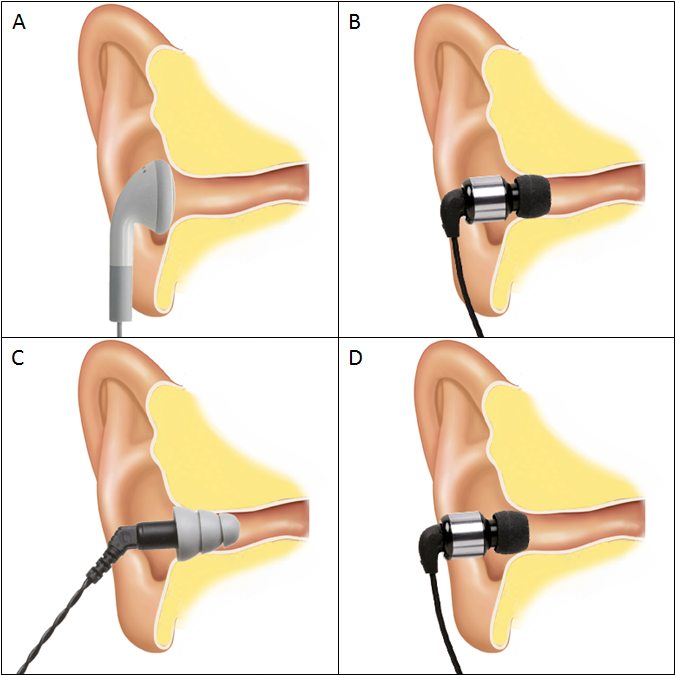
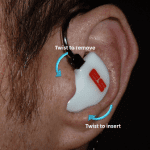

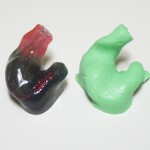

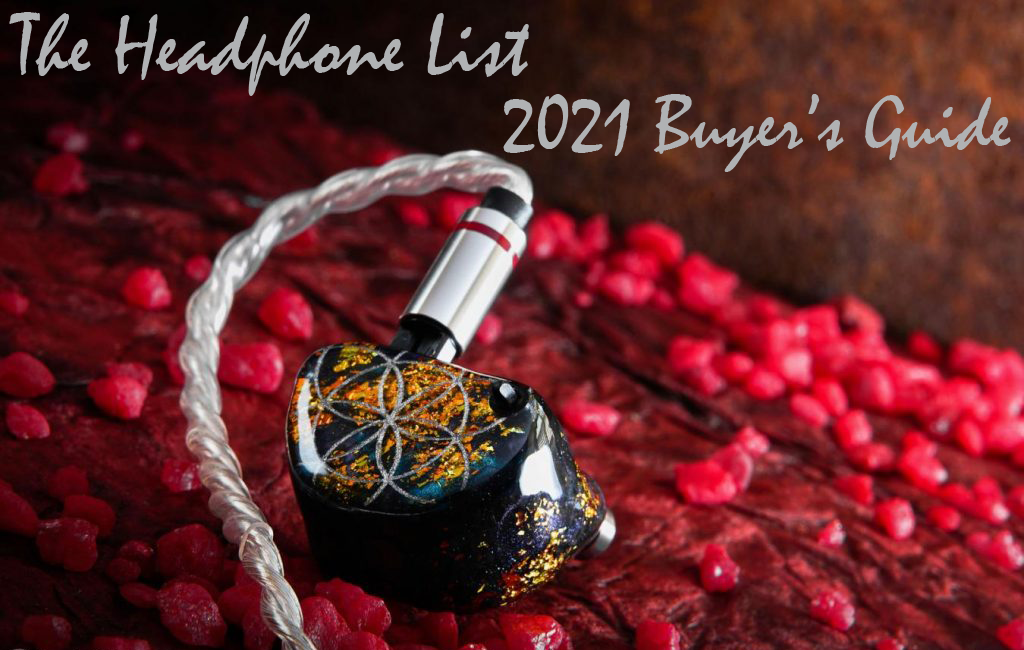
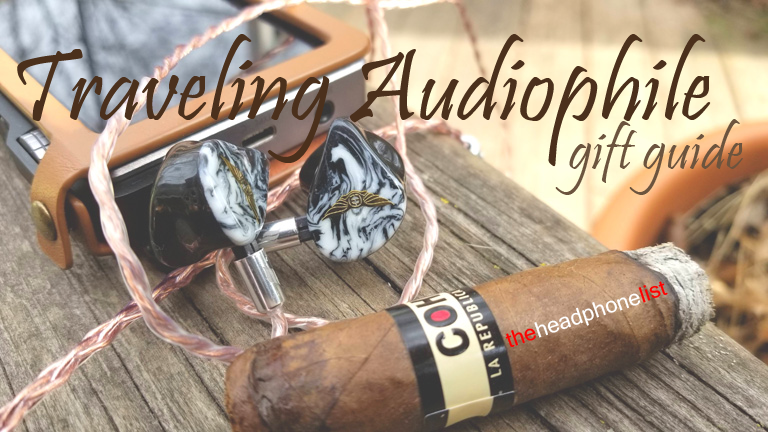

43 Responses
A really good article that stresses how important fit and proper seal is for these types of headphones. I think many are disappointed with the audio quality because they simply don’t make sure the fit is done properly. Any type of ear buds with silicon ear cups should include different size ones to adjust to different ear canal sizes. If they don’t, they should not even be considered.
Hi do you know of any wireless sets that fit small ears? I would love to have something to work with the Bluetooth on my Fitbit for running. The only pair I’m quite comfortable in was a set with a tip that fit just the end into your ear canal. I think they were marketed at women and came in purple. I have a photo but can’t find them online. They’re kinda like this shape https://goo.gl/images/KkxVk2.
A Meier crossfeed may help with the issue of things sounding a little too far to the sides. To me, it also makes depth a bit more accurate, but not necessarily “farther.” Just a lot easier to discern and more realistic.
Hi Jaimme, nice to know you here. we are the manufacture of earphones. are you interested in talk to me pleasE?
I have found that the most comfortable product is shaped like Urbanears’ Reimers, which is an earbud– in the old school definition of non-invasive product– with a silicone cover that is to the side. I’ve had the worst time trying to shop for these because (a) they use “earbud” do describe everything now, including invasive earphones and (b) there doesn’t seem to be any term that described these side-angled silicone covers.
Can you help? Am I missing something? When I look for angled- or side- buds, I usually get a bunch of the buttplug styled ear jammers that happen to be perpendicular to their fixture but aren’t themselves actually angled.
(Also looking for one with a mic and volume control, but those features are easy to search for.)
Thanks!
HI, I am a designer planning a comfortable long-time wearing earphone (12hours/per day ), can you give any suggestion? I really wanna do a good product for the delivers of our company.
Look at the FiiO FD5’s, I think that’ll help. Although they’re very expensive, if you’re trying to make an affordable one, I’ll break down all the things about the FiiOs that makes me recommend them.
The metal housing, the detachable cable, to replace it or even make them wireless if you choose, it has like 12 different silicon tips for both the ability to customize and even have your preferred tip type. Also, the cable it comes with isn’t noisy.
That’s obviously not everything, because the hardware is great. But obviously, if you’re going to make cheaper headphones you won’t get that high of quality but it can still be great. The FiiOs are audiophile level headphones. average person doesn’t need that.
Also, if you make true wireless headphones, they’re a lot harder to make good, because you have to put the battery in where the sound driver is. So unless you made them huge, you’re sacrificing audio quality over battery life. Cabled headphones have less delay and quality loss because of the wired connection. So if you made cabled headphones, where you could disconnect the cable and make them Bluetooth, by plugging in a Bluetooth band to it, that would be ideal.
I guess the better example is the KZ ZSN’s instead of the FiiOs. But yeah.
Anyway, this was a really long comment and most of this is based on my opinion about the headphones so do with it what you will.
Hello,
Thanks for your great review, that was very useful.
I upgraded my iem to get better isolation of noise/wind when I take the plane/ride my bicycle.
I picked the 1more quad and only discovered THL once my purchase was done. The review on this website is amazing with only negative being the shallow fit of the earphone. I do love the sound but agree that the isolation is not the best; which was the main thing I was looking to improve with my purchase..
I am still experimenting with the different eartips provided in the case but would appreciate if you have any recommendations of 3rd party eartips that could offer a better isolation. Or do you think that because the earphone is built with a shallow insert different eartips wouldn’t really improve the isolation and maybe I should try different iems?
Thanks in advance.
What a great guide! I discovered Klipsch oval tips and they fit my ear canals perfectly, but I’m wondering if there are any other brands that I can use those Klipsch tips with?
Thanks for your article, I know this sounds crazy however, the Conventional Earbuds are the best fitting for me. Like the Sony E9LP In-ear. I have trashed so many pair of these by snagging the wire its crazy, but, try to find a wireless set with that style of earbuds is apparently impossible, right?
The only option I could find was customizing a pair to fit my needs http://www.instructables.com/id/How-to-make-super-neat-and-easy-custom-fit-earbuds/
Suggestions, please advise.
Any idea if there is a way to build up the thickness of silicone iem’s? I have some as custom ones that don’t seal properly.
Thanks for sharing and glad to hear the guide was able to help you get a better seal and control the highs a bit. Cheers, Joe
After recently purchasing the Vsonic GR02 BEs, I read this article. It gave me the idea of using some cheap comply foam earplugs to make hybrid ear tips out of the double-flange tips included with the earphones. I was able to get a better seal in the smaller flange as well as take away some of the highs that I found a little overpowering for me.
I also tried doing the same for the larger flange, and I got even more sound isolation, but it felt like too much of the highs had gone away. I ended up ripping out the non-comply, open-cell foam found in the included hybrid tips and using them as well.
Hi Paul, thanks for reading and great to hear about the improvement!
Cheers,
Joe
I recently got my first pair of IEMs and was getting mixed results, e.g. massive variations in bass quantity, which I thought might be due to how they were fitting.
Thanks to your advice, I’ve managed to get both better comfort and a much more consistent sound.
It seems like your only criteria is small size. If you want something that’ll be flush in the ear your options are quite limited (more so if you have small ears). The safe choice would be an earphone that’s already designed for an ergonomic fit and fully closed so that you don’t have to worry about vents when making your molds. If you’re overseas, the Soundmagic PL50 may be a more practical (i.e. easy to find) option but in the US the Westone 1 would be a good one now that it’s <$100: http://amzn.to/1WuI3G1
I’m looking to get some fairly good sounding IEMs. I fly often, and am looking into making my own custom fit IEMs that are encased in molded silicone or one of the other available options (like Radians). How do I filter your great reviews for good options. I would like sub $100-ish models that will work well in this use. I’d like a form factor that is small enough that the completed unit will end up fairly close to flush with my ear so that if I have my head reading in a pillow it won’t feel like I I’m cramming the ear bud through my head. Since this approach gives a good seal, the out of the box seal rating doesn’t matter as much to me. Happy to hear any advice you have.
Thanks for the info! I would most likely stick to the large ones as those are similar to what i was using before this. just ordered the comply foam tips. will be arriving in a couple of days. see if I like it and I’ll decide if I want to go back to the rubber tips. 🙂
I don’t have a DTX160 but if it has the same standard nozzles like the DTX101/DTX102 (around 5-6mm in diameter), it should work fine with HiFiMan tips. The only HiFiMan tips that are troublesome are the short bi-flanges, which work best with a certain type of nozzle lip. Other HiFiMan tips, like their large bi-flanges, are very universal.
I lost one side of my beyerdynamic dx160ie’s tip today and stumbled upon your article. i was wondering if the HIFIMAN RE400 Flanges&Filters will fit my earbuds or not. still deciding between comply foam or the rubber ones. the durability of the foams made me think twice.
It’s worth trying all of the tips you have that will fit and listening for the improvements you want, but as far as a specific aftermarket tip to improve the soundstage depth of the W40, I don’t know of any.
The MH1C is smaller than average but not the smallest. I recommend the Fidue A31s for this as it’s a very tiny earphone and fairly inexpensive. Not as good-sounding as the MH1C, but it fits wonderfully in smaller ears.
Thank you for a well rounded article. Your expertise in “tip” ooses and I love it.
I bought some Westone W40. I received them yesterday. I fiddled around with them all day. I love their sound, clarity, detail, etc.
I only listen to classical music.
One thing I do not like is their sound stage. It seemed like the directors of all my orchestras have moved all their musicians on the front 2 rows :-). Plus the piano in concertos are often too much to the left, and occupy a large part of the small soundstage.
Are there any tip that would lmproved “soundstage” as far as depth is concerned? I read in your article about not putting them to far in the ears. I am told that “burning them in” will improve them. I don’t know if that stand to improve soundstage what do you think?
I’m really looking forward to the section about nozzle size.
Also, it’d be great if you could somehow search your reviews by nozzle size—I have tiny ears and NOTHING ever fits and I’m tired of spending money.
I might try the Sony MH1C. A friend of mine had Sony stock earbuds with an MP3 player about 5 years ago and they were the first ones that ever fit me, but I couldn’t find them anywhere. If you could recommend any other, seriously small earbuds I’d be grateful.
I probably could just going off of experience, but otherwise the most surefire way is a combination of the Left/Right markers on the earphones and whatever people-wearing-product images the manufacturer has on the website, packaging, etc.
Regarding cable down or over the ear, is there any way to know how the IEM’s were designed to be worn? I have a dozen pairs and I don’t use them all every day. Is there some trick you can use to determine the correct orientation by just looking at a pair? Could I hand you a pair of IEM’s you don’t recognize and have you tell me the orientation you’re supposed to use? Maybe it’s obvious (or maybe not according to what you wrote above), but I would have to look up each pair to know.
Yeah, now that we’ve established that there are IEMs that fit well you have some options. The best one if you’re willing to spend the money is the Klipsch X10 or X11: http://amzn.to/1U7Gbp6 . Very tiny earphones with great fit, and the Klipsch eartips are excellent, too. Not the absolute best value for sound quality alone but the combination of sound AND fit can’t really be beat.
If you don’t mind an over-the-ear fit you can also try the Westone W1/W10: http://amzn.to/1WTIj2x. These are tuned for a slightly more flat/reference sound than the enhanced-bass Klipsch. They also aren’t amazing value for sound quality alone and can probably be called a bit boring in terms of sound tuning, but they’re a nice single balanced armature earphone with a very comfy form factor.
In the absence of any other specific requirements (for sound tuning or otherwise) these two are what I’d be looking at.
I finally have received the headphones you suggested…..they fit perfectly, thank you.
I find that the quality of the sound not so good…. Well, I was not expecting anything more for that price. I will be using them for podcasts and stuff, but for music, would you be able to recommend me of another small earbud headphones that are of better sound quality.
Really appreciate your help/input.
Thanks
There are several IEMs that stay in place by virtue of ear canal seal alone – for example the skinny “straight” designs like the Etymotic Research HF5: https://theheadphonelist.com/headphone_review/etymotic-research-hf5-hf2-hf3/ . In this case the shape or size of the tragus shouldn’t matter as long as it’s not in the way.
Nice article. I just wondered; do all in-ear headphones require the tragus to hold them in place? As mine sticks out and won’t hold in any that I’ve tried.
I see, Thanks for the info! (: really appreciated it
No, eartips from two different earphones can be very different. Westone eartips have the smallest internal diameter. Typical eartips from Shure and Etymotic Research will fit Westone earphones as well.
I really appreciate your help. I will definitely try them.
Good read to understand the way things works for our ears with Technology. But just wondering, any idea if eartips are the same for all in-ear earphones/IEMs?
I’m looking for a eartip replacement for my Westone UM pro
They’re out there, just not as common – some have nozzle diameter as thin as 2.5mm.
A personal favorite for smaller ears that I’ve tried recently is the Fidue A31s: https://theheadphonelist.com/headphone_review/fidue-a31s-in-ear-earphone-review/ . Amazingly small earphones all around, and they come with smaller eartips than usual, too.
Interesting article…. I need an advice, My ear canals are narrow, but would like to get earphones/buds thatdkn’t fall off. I haven’t found a pair yet that will fit into my ears. The smallest one I found so far, the diameter of the inner sound projecting part diameter is 6mm.
Any advice will be greatly appreciated.
Thanks
Sorry Dan, a site update wiped out many of the links on the site. They should be restored soon, unfortunately it may take several days.
The links to the suggested tips don’t seem to be working. Any chance of updating them?
Thanks for reading. Let us know if you have any questions.
The article is very detail. It’s really useful information. Thank you
only foms!
It is not uncommon for those with asymmetric ear canals to have to use a different-sized eartip in each ear. Memory foam tips (for example those from Comply) are also a good solution as they typically accommodate a wider range of ears. If all else fails, there is always the one-time spend on custom eartips. They are pricy, but custom-made for your ears and pretty much guaranteed to fit. You would have to decide on an earphone first, however, as custom tips are typically designed to fit only a narrow range of products.
My one ear canal is slightly less deep and narrower. What should i do?